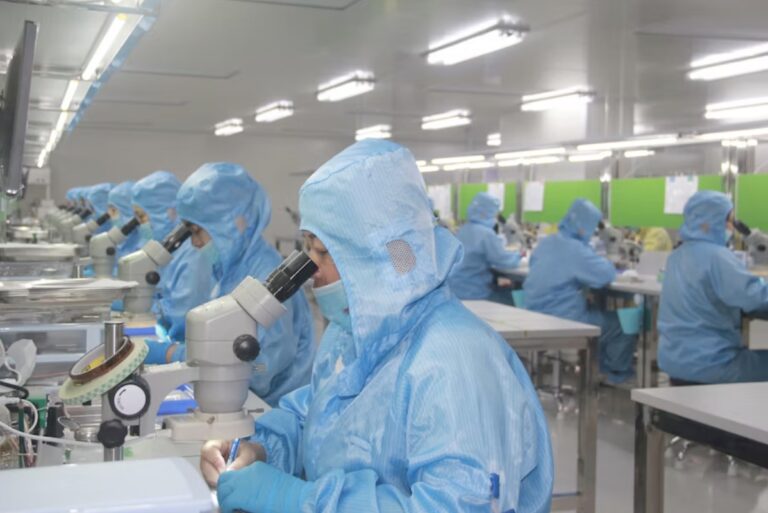While investigating the relationship between AI and the Coronavirus in China, we found unprecedented tech advancements in big data or AI in an effort to contain the outbreak. In fact, according to a WHO report that lists the finding of an expert investigation team sent between February 16 and 24, 2020 in China, “the implementation of [the] containment measures has been supported and enabled by the innovative and aggressive use of cutting edge technologies.” To better understand these applications of AI and big data during the Coronavirus in China to strengthen contact tracing and the management of priority populations, here is a peek at tech advancements from the Coronavirus in China to address the disease.
Boost for Chinese big data and AI in mass surveillance
The most visible use of new technologies during the Coronavirus in China are thermal scanners at Chinese stations and airports. With thousands of coming and going each day, these detection gates can accurately identify the body temperature of dozens of passengers simultaneously.
Facial recognition and infrared scanners
The Chinese AI company specialized in Facial Recognition Megvii, announced on February 7th that it had built a solution that “integrates body detection, face detection, and dual-sensing via infrared cameras and visible light.” This new temperature detection system has been supported by the Chinese Ministry of Science and Technology and was first deployed at a subway station in Haidan District on February 4th. The system is capable of simultaneously check the body temperatures of 15 people every second, even when masks or hats cover people’s faces.
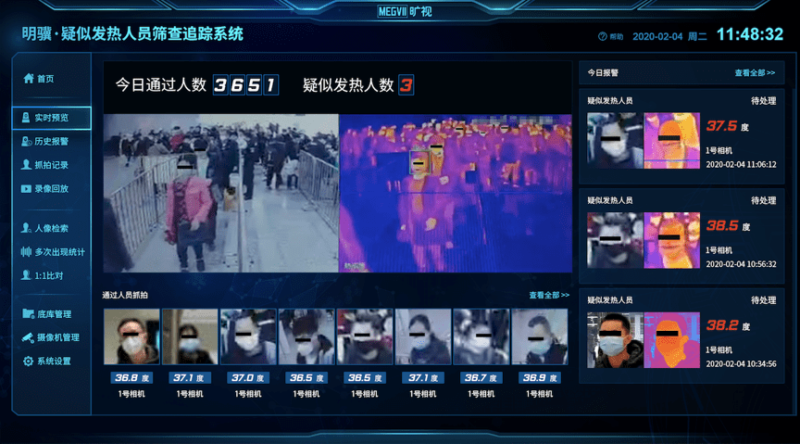
[Source: Megvii – New software equipped with facial recognition and temperature checking cameras]
Megvii is known to have been blacklisted by the US administration in October 2019 for its alleged human rights abuses. Facial recognition is indeed a subject of controversy, even in China. The widespread use of this tool to better control populations during the epidemic could, however, bury the privacy concerns of Chinese citizens. Megvii facial recognition devices are now being installed in more and more subway, train, and airport stations. The use of facial recognition by the authorities could, therefore, be enforced in the long term.
Big data powered QR codes
The Alipay’s Health code is another example of the use of big data to implement epidemic control, a newly automated form of social control that could persist long after the epidemic subsides.
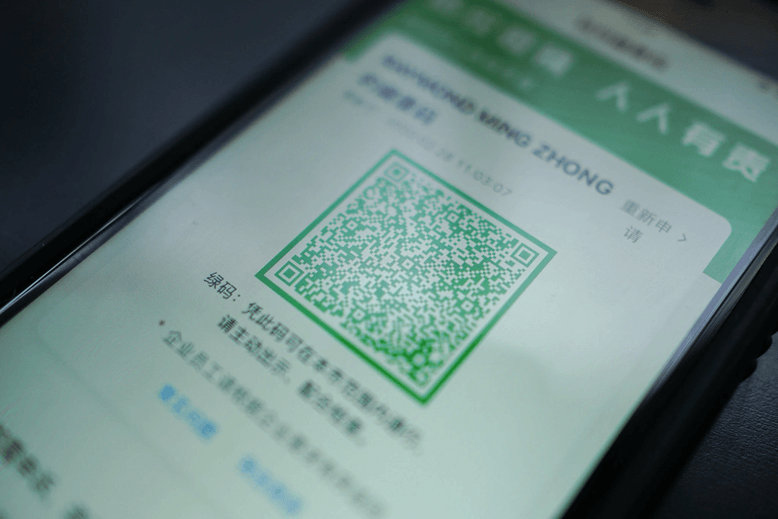
[Source: New York Times – Color codes, one of the AI solutions to the Coronavirus in China]
Launched at the end of February by Alibaba’s part-owned Ant Financial, the QR code is available in more than 200 cities across China on the popular wallet app Alipay. The color code, green, yellow, or red, indicates people’s health status. A green QR code allows free access to public places such as subways, malls, or even supermarkets. The yellow QR code forces you to a seven-day quarantine, while the red one requires a fourteen-day quarantine.
Government tracking of APPs feeds AI development during the Coronavirus
While QR code checkpoints are becoming standard across China, neither the company nor officials have explained how the system decides whether someone is green or not. However, it seems that the QR code bases its arbitrations on the history of the user’s location coupled to information data on the Coronavirus. A yellow or red code may be therefore given to someone who has visited cluster areas or had contacts with an infected person.
There is still no consensus regarding how to marry the right for privacy and the responsibility of the government to stop a deadly epidemic. A huge amount of data has been made available by the authorities’ consistent tracking of so many apps, which feeds Artificial Intelligence in China during the Coronavirus.
New healthcare technologies to fight against the Coronavirus
In the first weeks of the outbreak, much has been written in scientific journals across the globe after Baidu has developed an algorithm that only takes 27 seconds to solve the RNA secondary structure of the Covid-19 which is 120 times faster than the top classic algorithms. On January 30, the tech giant that operates the country’s largest search engine opened up its prediction algorithm, ‘LinearFold‘ to global genetic agencies and scientific research institutes, for free. This scientific feat took place in the early stages of the outbreak in China, followed later by other AI solution to the Coronavirus in China. These advances in healthcare technology could set a new precedent for pandemic prevention in the future.
AI in China to diagnose Coronavirus
Deep learning, the same technology that makes possible facial recognition or autonomous driving, is also making it possible to diagnose Coronavirus faster than doctors. We have seen giant Chinese tech companies relying on machine learning to develop diagnosis chatbots on their platforms. Based on thousands of real diagnoses, as well as questions asked to the user through the chatbot, Baidu or Tencent algorithms can identify if the user’s symptoms match those of the Coronavirus.
Smart CT Scans
New technologies from the Coronavirus in China also include capabilities to read computed tomography (CT) scans. CT scans of the chest are indeed a critical method in diagnosing the Coronavirus. Alibaba and health insurance company Ping’An has developed smart image reading systems that can deliver results in about 15 seconds with an accuracy rate above 90%. Such tech advancements from the Coronavirus in China significantly speed up the process, as radiologists can spend up to 15 minutes reading the CT images of a patient suspected of contracting COVID-19.
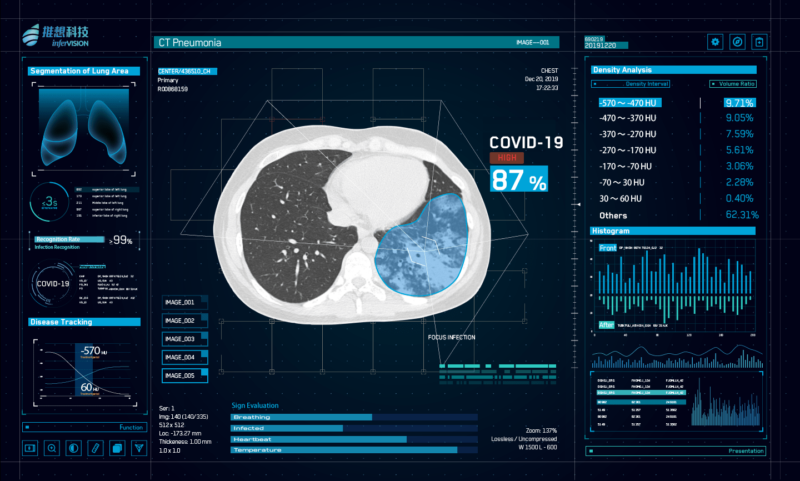
[Source: Infervision – Tech advancements from the Coronavirus in China to help reading CT scans]
Infervision is another Chinese Artificial Intelligence startup that has developed CT Pneumonia reading software to detect lesions from possible pneumonia caused by the Coronavirus. Before the outbreak, the company was specialized in detecting lung cancers through CT chest scan reading. Bringing its AI solutions to the Coronavirus in China, the whole diagnosis analysis process can take as little as 10 seconds. As of March 5, the Infervision’s system has been deployed in 34 hospitals across China and reviewed over 32,000 cases.
Deployment of disinfection robots
In hospitals often overwhelmed by new cases, addressing hospital-acquired infections remains a considerable challenge for medical workers. Given the contagiousness of the Coronavirus and the density of patients in Chinese hospitals during the outbreak, the deployment of unmanned disinfection systems is a necessity.
UVD robots is a Danish company which supplies Chinese hospitals with disinfection robots during the Coronavirus. The robots consist of a base equipped with sensors, surmounted by powerful UV lamps. This kind of disinfection technology using UV lamps has been around for a while – used in the disinfection of drinking water, for example – before being deployed in hospitals. This technology consists of pointing a high-intensity UV light – which can be harmful to human skin or eyes – on contaminated areas during a few minutes.
The robot scans its environment using its lidars, creating a digital map that medical workers can annotate, indicating the areas to be disinfected. The robot can then navigate on its own, relying on simultaneous localization and mapping (SLM), without any human interaction. The disinfection of a room can takes up to ten minutes. For safety, the robot shuts UV lights off when detecting a person through its sensors.
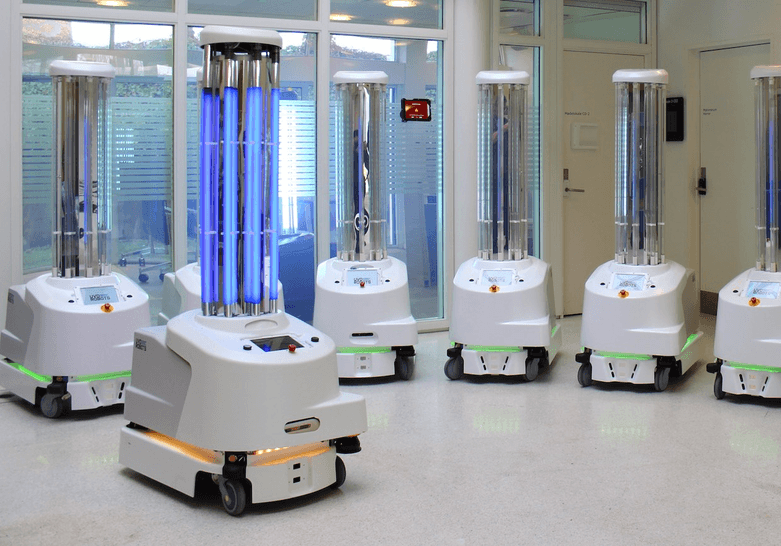
[Source: Spectrum – Danish UVD robots to push AI innovation in China during the Coronavirus epidemic ]
During the epidemic, the Danish company shipped robots to China by plane every week to cope with the demand. On February 19, UVD Robots announced that it would equip all the Chinese provinces, deploying its robots in more than 2,000 hospitals. Given the globalization of the epidemic, UVD robots will be deployed at other medical facilities in the United States. In the near future, this kind of technology could also extend to schools, cruise ships, or other usually crowded spaces that offer like-hospital structured places.
Spreading information faster than the Coronavirus
In times of pandemic, giving accurate and precise information to the public is the first step to ensure broad awareness and implement prevention to strengthen epidemic control. But with people getting scared, it is easier for fake news and hoaxes to spread better than a valuable accurate piece of information. Moreover, with a situation evolving really fast, something that was still true a few hours ago may now be out of date. To ensure proper transmission of information to populations, AI and Big Data in China during the Coronavirus intensified their effort towards new ways of informing Chinese people.
Online information centers rely on Chinese AI and big data during the Coronavirus
As previously noted, AI solutions to the Coronavirus in China include the recourse to machine learning processing bots. On February 4, in the early weeks of the epidemic, JD launched a ‘smart epidemic assistant’ integrated into the WeChat account of Wuhan’s Mayor to accurately answer Wuhan’s dwellers’ inquiries. Its functions are further detailed in this article. More generally, the giant Chinese companies such as Baidu, Tencent, Alibaba, JD, Meituan all released a big data-powered information center on their platforms. These powerful tools inform people about the latest news on the Coronavirus, displaying statistics, transmission rates, and other virus-related queries. It also provides information about the nearest hospitals, self-testing features, and online medical services.
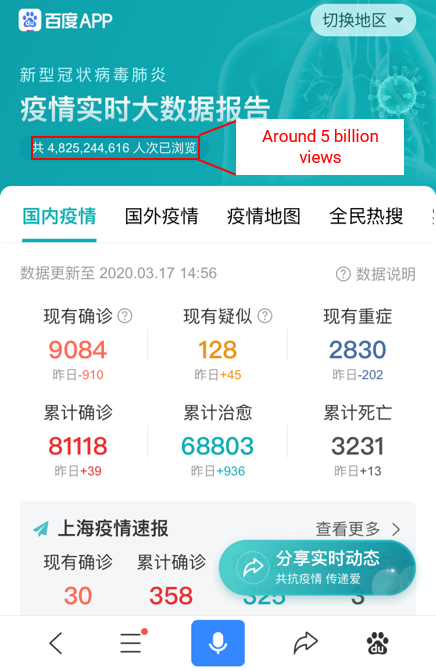
[Source: Baidu app – Information center about COVID-2019]
These tech advancements from the Coronavirus in China quickly became widespread, with 34% of the Chinese said they tried online medical consultancy for the very first time thanks to the epidemic. As of March 17, the most consulted online health center, which is Baidu’s, has been seen close to 5 billion times.
Big data-powered maps
Among AI solutions to the Coronavirus in China, Baidu, the tech giant that operates China’s largest search engine, launched several maps to help people find their way through the epidemic. An ‘epidemic map’ displayed the number of contaminated and suspected cases in a certain area, while a ‘migration trend map’ was helping people check the migration status of Mainland cities during the Spring festival. The two apps were making it easier for people to manage their travel plans to go back home at the end of the holidays, as well as avoid risky places.
Last to date is the ‘resumption work map’, which shows all the shops open around. Since the quarantine that forced millions of stores to close, it’s indeed hard to tell what’s open from what’s not. This new feature is available in more than 300 cities and allows the user to select the type of spot they want to search for, from supermarkets to parks and hotels. Those identified as open appear on the user’s screen.
The adoption of AI and big data in china during the Coronavirus at all levels of society
From disinfection robots to color codes, China is perhaps the best example of how technology has moved from being nice-to-have to essential to address the disease. The examples listed above are some of many highlighting the widespread use of AI and Big Data in China during the Coronavirus. Tech advancements from the Coronavirus in China are now everywhere for everyone, boosting innovation in China.
Big data platforms to help the Chinese government with decision making
During the epidemic, more than 20 province’s government worked with technology companies to build AI solutions to the Coronavirus in China to report epidemic related data and feedback, providing invaluable advice for public crisis management of priority populations. Deeper cooperation between the two parts to fight the Coronavirus supported tech advancements from the Coronavirus in China.
From March 2020, two months after the initial economic impact of the outbreak, Chinese authorities are now focusing their efforts to find a balance between epidemic prevention and control, social development and sustainable economic recovery after COVID19. Proof that AI and big data during the Coronavirus in China has been of invaluable help at the highest political levels in managing the crisis, Chinese President Xi Jinping said on March 5 that unprecedented expenditure on “new infrastructures such as 5G networks and data centers” will top the Chinese response to the economic impact of the Coronavirus. The comment confirmed that investments would be made to support new technologies and innovation in China. Stocks related to AI, big data storage center, and 5G, surged in response.
The real power of technology
Ordinarily, only a few people try new tech products and help to push the boundaries of technologies further. These people are called early adopters, geeks, or innovators. The Coronavirus situation forced the majority, the later adopters, to catch up fast. As it created an unprecedented launchpad for AI, big data, and robotics developments in China, consumers, producers, marketers, and decision-makers will come better to understand their potential in all walks of life.
If no one knows when the pandemic will end, it looks certain that new technologies from the Coronavirus in China will last. These AI solutions to the Coronavirus in China, but not only, were born out of a necessity to cope with an unprecedented situation. With the virus expanding worldwide, tech advancements from the Coronavirus in China will be of great help to other countries globally. By its essence, technology has no borders or nationality. It can easily scale up to solve threats elsewhere.
Author: Maxime Bennehard
Let China Paradigm have a positive impact on your business!
Listen to China Paradigm on iTunes




